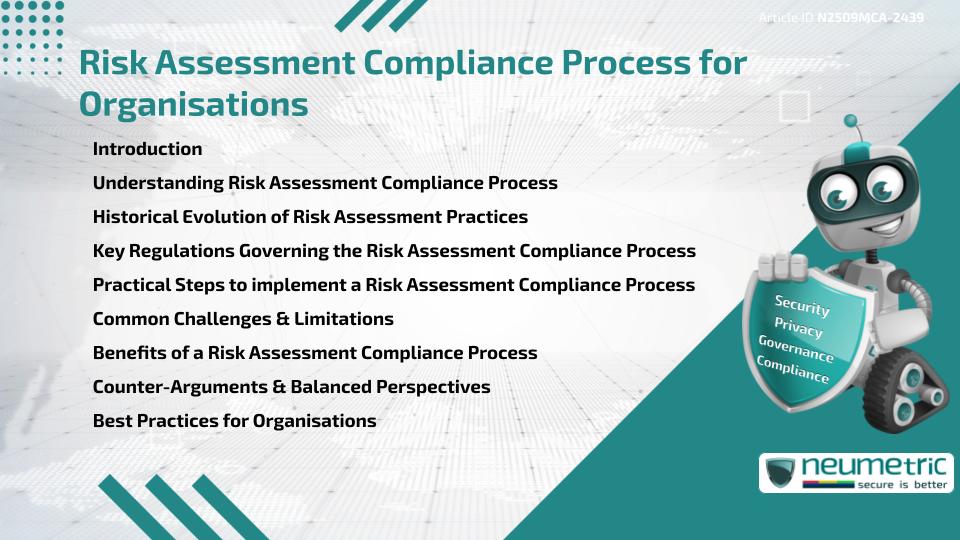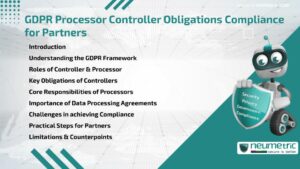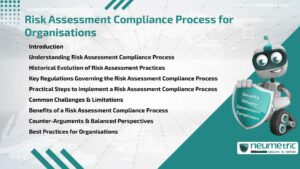Table of Contents
ToggleIntroduction
A Risk Assessment Compliance process is essential for organisations aiming to identify Vulnerabilities, meet Regulatory obligations & strengthen Governance. It provides a structured Framework to evaluate Threats, measure potential impacts & implement controls that satisfy Legal & Industry Standards. By adopting a Risk Assessment Compliance process, organisations can minimise Financial losses, avoid Penalties & build Operational resilience. This article explores the history, regulations, benefits, challenges & Best Practices of implementing a Risk Assessment Compliance process.
Understanding Risk Assessment Compliance Process
The Risk Assessment Compliance process involves identifying Risks, analysing their Likelihood & Impact & aligning mitigation measures with Compliance Requirements. Similar to a health check-up for an organisation, this process ensures early detection of issues before they become critical. It also demonstrates Accountability to Regulators, Stakeholders & Clients.
Historical Evolution of Risk Assessment Practices
Risk Assessments date back to early Insurance & Financial systems, where Risks had to be measured for underwriting & investment decisions. In the late 20th century, industries such as Banking, Healthcare & Energy adopted formal Compliance-driven Assessments to address rising regulatory scrutiny. Today, the Risk Assessment Compliance process spans Cybersecurity, Environmental Sustainability & Data Privacy, reflecting the complex Risk landscape modern organisations face.
Key Regulations Governing the Risk Assessment Compliance Process
Several global frameworks & regulations drive Risk Assessment Compliance:
- Sarbanes-Oxley Act [SOX]: Establishes Financial reporting & Governance requirements.
- General Data Protection Regulation [GDPR]: Requires organisations to assess Risks related to Personal Data processing.
- Health Insurance Portability & Accountability Act [HIPAA]: Mandates Security Risk Assessments for Healthcare Data Protection.
- ISO 31000: Provides international principles for Risk Management frameworks.
- NIST Risk Management Framework: Offers structured methods for assessing & mitigating security Risks.
Practical Steps to implement a Risk Assessment Compliance Process
To effectively implement this process, organisations should:
- Identify & categorise assets, processes & data.
- Map Compliance Requirements to operational Risks.
- Assess Likelihood & Potential Impact of Risks.
- Develop & implement mitigation strategies.
- Document findings & actions for Audit readiness.
- Conduct regular Reviews & update Assessments as conditions evolve.
Common Challenges & Limitations
Enterprises often face challenges such as high costs, limited expertise & difficulties in integrating multiple Compliance frameworks. Overly rigid processes may stifle innovation, while inconsistent documentation can weaken Audit readiness. Another limitation is the Risk of treating Compliance as a one-time exercise rather than a continuous process.
Benefits of a Risk Assessment Compliance Process
An effective process provides multiple advantages:
- Reduces Legal & Financial penalties.
- Strengthens Governance & Accountability.
- Improves operational resilience against disruptions.
- Enhances Stakeholder Confidence & Trust.
- Provides actionable insights for strategic decision-making.
Counter-Arguments & Balanced Perspectives
Critics argue that focusing heavily on Compliance may create a “Checklist culture” that overlooks real Risk Management. Others note that smaller organisations may lack the resources to implement comprehensive assessments. A balanced approach blends Regulatory Compliance with practical, Risk-based decision-making tailored to organisational size & industry.
Best Practices for Organisations
- Align Risk Assessment with broader organisational strategy.
- Automate Monitoring & Reporting processes where possible.
- Engage cross-functional teams to capture diverse perspectives.
- Update Risk Assessments regularly in line with Regulatory & Operational changes.
- Use external experts to validate & strengthen Assessment outcomes.
Conclusion
The Risk Assessment Compliance process is more than a Regulatory necessity-it is a strategic tool for Governance & Resilience. By understanding its history, regulations, challenges & benefits, organisations can establish frameworks that protect them from penalties, strengthen Stakeholder Trust & enable smarter Decision-making.
Takeaways
- A Risk Assessment Compliance process aligns Risk Management with Regulatory requirements.
- SOX, GDPR, HIPAA, ISO 31000 & NIST shape global Compliance expectations.
- Implementation requires identification, analysis, documentation & continuous updates.
- Challenges include high costs, lack of expertise & potential rigidity.
- Balanced approaches combine Compliance with practical Risk-based strategies.
FAQ
What is a Risk Assessment Compliance process?
It is a structured Framework for identifying, analysing & mitigating Risks while meeting Regulatory obligations.
Why is a Risk Assessment Compliance process important?
It reduces exposure to Legal penalties, improves Governance & enhances organisational Resilience.
Which regulations influence Risk Assessment Compliance?
Key frameworks include SOX, GDPR, HIPAA, ISO 31000 & the NIST Risk Management Framework.
What challenges do organisations face in implementing Risk Assessment Compliance?
They face high costs, resource limitations & difficulties integrating multiple Compliance Requirements.
How often should Risk Assessments be conducted?
They should be performed regularly, with updates whenever business processes, technologies or regulations change.
Does Compliance alone ensure Risk Mitigation?
No, Compliance is part of the process, but effective Risk Mitigation requires practical & ongoing strategies.
Can small organisations implement a Risk Assessment Compliance process?
Yes, but they may adopt simplified or scaled frameworks that align with their size & resources.
Need help for Security, Privacy, Governance & VAPT?
Neumetric provides organisations the necessary help to achieve their Cybersecurity, Compliance, Governance, Privacy, Certifications & Pentesting needs.
Organisations & Businesses, specifically those which provide SaaS & AI Solutions in the Fintech, BFSI & other regulated sectors, usually need a Cybersecurity Partner for meeting & maintaining the ongoing Security & Privacy needs & requirements of their Enterprise Clients & Privacy conscious Customers.
SOC 2, ISO 27001, ISO 42001, NIST, HIPAA, HECVAT, EU GDPR are some of the Frameworks that are served by Fusion – a SaaS, multimodular, multitenant, centralised, automated, Cybersecurity & Compliance Management system.
Neumetric also provides Expert Services for technical security which covers VAPT for Web Applications, APIs, iOS & Android Mobile Apps, Security Testing for AWS & other Cloud Environments & Cloud Infrastructure & other similar scopes.
Reach out to us by Email or filling out the Contact Form…





